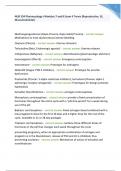1
NUR 334 Pharmacology I Modules 7 and 8 Exam 4 Terms (Reproductive, GI,
Musculoskeletal)
Medroxyprogesterone (Depo-Provera, Depo-SubQ Provera) - correct answer
Medications to treat dysfunctional uterine bleeding
Oxytocin (Pitocin) - correct answer Uterine stimulant
Terbutaline (Beta 2 Adrenergic agonist) - correct answer Uterine relaxant
mifepristone (Mifeprex) - correct answer Abortifacients (pharmacologic abortion)
levonorgestrel (Plan B) - correct answer Emergency contraception
testosterone - correct answer Prototype for androgens
Sildenafil (Viagra: PDE-5 inhibitor) - correct answer Prototype for erectile
dysfunction
finasteride (Proscar: 5-alpha reductase inhibitor); tamsulosin (Flomax: alpha 1
adrenergic receptor antagonist) - correct answer Prototypes for benign prostatic
hyperplasia
Estradiol, Norethindrone - correct answer estrogen contraceptives
Monophasic contraceptives - correct answer provide a fixed concentration of
hormones throughout the entire cycle with a "pill-free period" for a week during
use of the pill
Biphasic contraceptives - correct answer Fixed estrogen dosed combined with a
low progesterin dose for the first 10 days and a higher dose for the rest of the
cycle. Available in 21 or 28 day packages
Triphasic contraceptives - correct answer contains three different doses of
hormones in the pill that changes each week throughout the cycle
preventing pregnancy; when an appropriate combination of estrogen and
progestin is in the bloodstream, release of FSH and LH is inhibited, thus
preventing ovulation - correct answer Mechanism of action of estradiol and
norethindrone
, 2
hypertension, thromboembolic disorders - correct answer Adverse effects of
estradiol and norethindrone
cigarette smoking, coronary artery disease, stroke, thromboembolic disorders,
breast cancer or any estrogen-fed cancer, history of jaundice with oral
contraceptive use or pregnancy, liver tumors, known or suspected pregnancy -
correct answer Contraindications of estradiol and norethindrone
tranexamic acid (increased risk for thromboembolic events); rifampin, some
antibiotics, barbiturates, anticonvulsants, protease inhibitors, antifungals
(decrease effectiveness of contraceptives); warfarin, heparin, certain other
anticoagulants have decreased effectiveness due to contraceptives - correct
answer Drug interactions with estradiol and norethindrone
mood disturbances, depression, irritability, insomnia, hot flashes, irregular
menstrual cycles, headaches - correct answer Symptoms of early menopause
vaginal atrophy, increased infections, painful intercourse, skin atrophy, stress
urinary incontinence, sexual disinterest - correct answer Symptoms of
midmenopause
cardiovascular disease, osteoporosis, Alzheimer's-like dementia, colon cancer -
correct answer Symptoms of postmenopause
treat moderate to severe symptoms of menopause caused by diminished
secretion of estrogen by the ovaries - correct answer Mechanism of action for
conjugated estrogens
nausea, breast tenderness, weight gain, breakthrough bleeding, fatigue, skin rash,
acne, breast fullness, dysmenorrhea, etc. - correct answer Side effects of
estradiol and norethindrone
nausea, fluid retention, edema, breast tenderness, abdominal cramps, bloating,
appetite changes, acne, mental depression, decreased libido, headache, fatigue,
nervousness, weight gain, acute pancreatitis - correct answer Side effects of
conjugated estrogens
increased risk for breast cancer, endometrial cancer, stroke, deep vein
thrombosis, myocardial infarction, pulmonary emboli, dementia - correct answer
Adverse effects of conjugated estrogens




